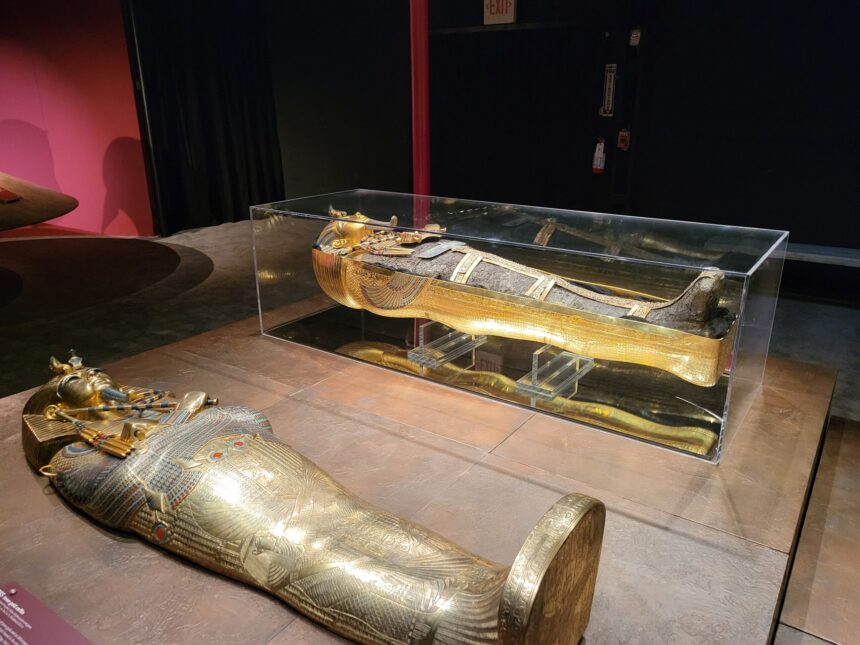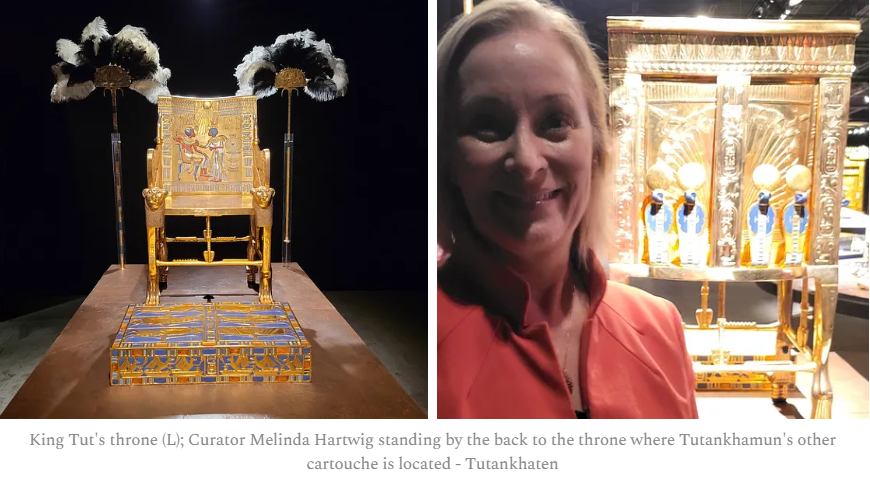
See and experience the Boy King in a way not previously possible. It’s the perfect get-away for families this summer.
When Akhenaten became Pharoah of Egypt during the 18th Dynasty (1539 B.C.E. – 1292 B.C.E.), he threw Egyptian society into chaos by ending the worship of all gods but one – Aten; the sun disk.
Some scholars describe this as the first true monotheism in the world. That’s partly true, says Melinda Hartwig of Emory University, but what he really did was to “proclaim the sun, the sun disk, the ‘Aten,’ as the thing that everyone should worship. The reason he did that is because the only way you could worship the Aten was through Akhenaten.”
His son Tutankhaten was only nine when he came to the throne, and probably had advisors around him says Hartwig. “They were the ones who probably pushed him to go back to polytheism,” so the people could have their household gods and all the festivals that they desired.
In the second year of his reign, the young king signaled his movement away from the worship of Aten by changing his name, taking on the one he’s better known by – Tutankhamun. And in so doing breaking his tie to the “Aten.”
Or did he abandon the singular worship of Aten?
A new Washington, D.C., exhibit that Hartwig curated at the Rhode Island Center, Tutankhamun: His Tomb and His Treasures, gives visitors an up-close-and-personal glimpse of a tantalizing clue that might suggest the Boy King wasn’t ready to completely throw off the worship of Aten his father had established.

The throne on display that Tut ruled from was his father’s, and it contains the cartouche of not just the name the Boy King is best known by – Tutankhamun – but on the back Hartwig points out his earlier name, Tutankhaten.
Was this just an oversight? Or was this Tut’s way of ensuring that the Aten remained prominent? Had he lived longer, might Tut had restored the worship of Aten as the only religion?
We can’t know the answers to these questions. But this does give the general public a deeper look into the intricacies of Egyptian life than ever before possible.
It’s the kind of thing that makes history come alive for children bored with summer, as well as their adults.
Models to Brag About
The treasures of Tut are no longer accessible to the general public. Rather, they’re under lock and key in Cairo, Egypt. And for a variety of reasons – insurance, concerns over damage, travel costs – it’s unlikely those treasures will ever be brought out of Egypt and allowed to travel the world again.
So what are these treasures at the exhibit in Washington? They are remarkably detailed reproductions of the originals made by Egyptian craftsmen.
While visitors may initially view this as a letdown – there is, after all, an undeniable aura that comes with standing before the original artifact from a place far removed from us in time and space – they will quickly embrace the extraordinary opportunity that these replicas present.
Due to their high level of accuracy – Hartwig points out in the paintings that the recreators even captured the mold that exists on the original paintings – people are able to not just see these works of art, but touch them and examine them in a way that no public exhibit of the actual treasures could ever allow.
Consider, for example, Tut’s tomb.
The sarcophagus that held the body is just one piece of the burial chamber. There were in addition to the stone sarcophagus another two inner coffins, as well as four shrines protecting the dead pharaoh, each piece nested inside the other.
Visitors can walk around the four outer shrines of the tomb, as well as the inner coffins, as a guided audio tour explains in intricate detail what they are observing.
Visitors, however, can also look inside the outermost shrine and see projected on the floor the outlines for where each of the smaller pieces – including the sarcophagus – would have been nested.

It’s a look that even Howard Carter, the archaeologist who unearthed the tomb, didn’t have when he entered the burial chamber in 1922.
The Sense of Discovery
Of course, nothing could ever replace the experience Carter had. But the exhibit does try and give visitors an understanding of the layers Carter worked through as he unsealed door after door.
In the first room, visitors are introduced to the Rosetta Stone, which proved the key to what until that time had been the untranslatable hieroglyphics.
[Editor’s note – It was the reproduction of the Rosetta Stone that shook my own skepticism about viewing models instead of originals. Having seen the original in the British Museum, I was impressed by not just the size and texture of the reproduction, but the coloring.]

Visitors then progress, room by room, in the same sequence that Carter himself moved through the tomb.
“You get a chance to see it through Carter’s eyes, when he opened the door to the antechamber, the burial chamber, and then over there in the treasury …. You’re the explorer.”
Planning Your Trip
The exhibit is located at 524 Rhode Island Ave NE. But be warned – Don’t trust your GPS system. It will take you on the opposite side of Rhode Island Avenue from the exhibit, near a U-Haul dealership.
The day I attended, I wasn’t the only journalist so misinformed by technology.
Take North Capitol Street NW, then turn right on Rhode Island Avenue. On the left, you will see a BP Gas Station and a McDonald’s. Immediately past the McDonald’s is a ramp that you drive up to the exhibit site.
Plan to spend at least an hour in the exhibit halls. To really absorb the presentation, allow two. The audio tour, which is included with your admission price, is well worth the time.
Tickets are $37.50 for adults and $28.90 for children under the age of 12. You should purchase them in advance.
It’s a solid 1.5 hour drive from Fredericksburg with minimal traffic (for this region), so allow plenty of time.





